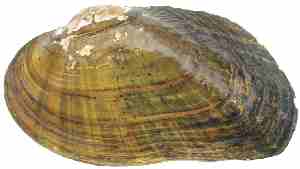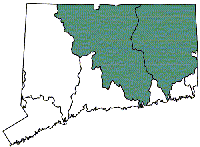Brook Floater
Alasmidonta varicosa
Endangered Species
Key Features
Size: Up to three inches.
Shape: Subovate or subtrapezoidal. Ventral margin flat or indented. Valves laterally inflated, appearing swollen in cross section.
Periostracum: Color yellowish-green (juveniles) to greenish-brown (adults). Shell rays numerous, usually green. Well-defined ridges present on the dorso-posterior slope, perpendicular to growth lines.
Lateral Teeth: Absent.
Pseudocardinal Teeth: Present but poorly developed—one small thin tooth on each valve.
Nacre: Color variable, but usually bluish-white or pale orange.
Other: Cantaloupe colored foot. Animals gape (relax muscles and allow shells to open) when removed from the water.
Often Confused With ... Dwarf wedgemussel, triangle floater, creeper

External shell

Internal shell, right valve

Hinge teeth
 Habitat: The brook floater is found in small to medium-sized rivers, usually in gravel and cobble substrates in swift current. This species is not found in lakes or ponds.
Habitat: The brook floater is found in small to medium-sized rivers, usually in gravel and cobble substrates in swift current. This species is not found in lakes or ponds.
Range in Connecticut: The brook floater is found in fewer than a dozen streams in the Connecticut and Thames River watersheds. In 2010, the brook floater was found in the Housatonic River watershed, where it had not been documented in over 90 years.
Conservation: The brook floater is endangered in Connecticut. Only a few known populations remain, and they are small and show little evidence of successful reproduction. Pollution, dams, and introduced species are thought to be the primary culprits for its rarity. The species is also endangered in Massachusetts and New Hampshire, threatened in Vermont, special concern in Maine, and possibly extinct in Rhode Island.
Freshwater Mussel Fact Sheets
Eastern Pearlshell
Dwarf Wedgemussel
Triangle Floater
Brook Floater
Creeper
Eastern Elliptio
Eastern Floater
Alewife Floater
Eastern Pondmussel
Tidewater Mucket
Yellow Lampmussel
Eastern Lampmussel
The Freshwater Mussels of Connecticut
Content last updated on January 29, 2014.

